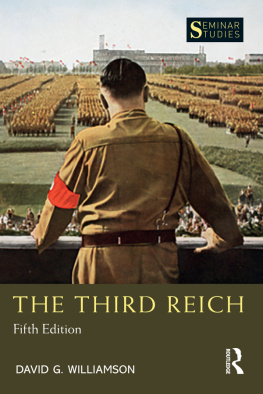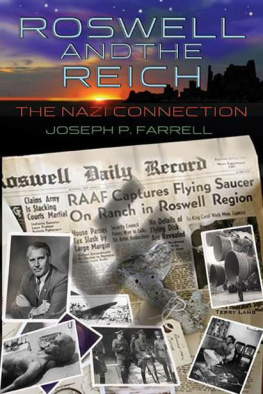
This edition is published by PICKLE PARTNERS PUBLISHINGwww.picklepartnerspublishing.com
To join our mailing list for new titles or for issues with our books picklepublishing@gmail.com
Or on Facebook
Text originally published in 1998 under the same title.
Pickle Partners Publishing 2015, all rights reserved. No part of this publication may be reproduced, stored in a retrieval system or transmitted by any means, electrical, mechanical or otherwise without the written permission of the copyright holder.
Publishers Note
Although in most cases we have retained the Authors original spelling and grammar to authentically reproduce the work of the Author and the original intent of such material, some additional notes and clarifications have been added for the modern readers benefit.
We have also made every effort to include all maps and illustrations of the original edition the limitations of formatting do not allow of including larger maps, we will upload as many of these maps as possible.
THE REICH WRECKERS: AN ANALYSIS OF THE 306 TH BOMB GROUP DURING WORLD WAR II
BY
CHARLES J. WESTGATE III, MAJOR, USAF
TABLE OF CONTENTS
Contents
TABLE OF CONTENTS
REQUEST FROM THE PUBLISHER
ILLUSTRATIONS
- Unit Crest for the 306 th Bombardment Group (H).
- B-17 with Triangle H Markings of the 306th.
- 367 th Bomb Squadron Patch.
- 368 th Bomb Squadron Patch.
- 369 th Bomb Squadron Patch.
- 423 rd Bomb Squadron Patch.
- Comparison of Number of Aircraft Losses.
- Comparison of % Losses.
- Normalized Comparison of Losses.
- Accuracy of Bombing Techniques for Eighth Air Force.
- Princess Elizabeth Christening The Rose of York.
- Causes of Sortie Aborts.
- Number of Enemy Aircraft Claims.
- Mission Effectiveness for the 306 th Bomb Group.
- Number of Missions per Month for the 306 th .
- Analysis of the 306 th s Losses.
- Analysis of 306 th s Enemy Claims.
- Normalized Comparison of Effective Sorties.
- Comparison of % Losses per Effective Sortie.
- Normalized Comparison of Enemy Claims.
- Comparison of Enemy Claims per Effective Sortie.
TABLES
- Flak Losses.
- Awards and Decorations.
- 306 th Mission Summary.
- 306 th Bomb Group Monthly Summary.
- Comparison of the 306 th BG and Eighth Air Force.
- Bombs Dropped by Eighth Air Force on Specified Targets.
- 1942 Bombing Percentages.
- 1943 Bombing Percentages.
- 1944 Bombing Percentages.
- 1945 Bombing Percentages.
- Top Three Targets Based on Tonnage of Bombs Dropped.
ABSTRACT
This paper presents an analysis of the 306 th Bomb Groups contributions during World War II. Rather than providing a simple recounting of the various dates and accomplishments, the paper analyzes some of the key indicators and statistics of the groups performance. In particular, the paper focuses on comparing aircraft losses and bombing results of the 306 th with the Eighth Air Forces. The analysis also examined other areas, such as: mission aborts, enemy aircraft claimed destroyed, weather conditions over target, bombing methods used, presence of fighter escorts, and strength of enemy air defenses (enemy fighter aircraft and flak). The purpose of the analysis was to gain a better understanding of the groups overall performance within the bigger scope of the Eighth Air Forces war effort.
The analysis was conducted in three steps. First, the archives of the Air Force Historical Research Agency (AFHRA) were searched for statistics on the 306 th . Next, similar statistics were collected for the Eighth Air Force. Finally, the data for the two units was analyzed and compared, to aid in determining conclusions. To facilitate the last step of the research, the air war was divided into four periods. The goals and objectives for each period were used as criteria to grade the units effectiveness.
In general, the study concluded that the 306 th Bomb Group was a typical B-17 bomber group in World War II. When comparing the various statistics and graphs provide in this paper, we see that in most cases there was little difference in the data for the 306 th and the Eighth Air Force. However, the statistics do not tell the whole story. As one of the cadre groups of the Eighth Air Force, many of the improvements and lessons learned during the early period of the war were at the expense of the 306 th . These early lessons and experiments were important and led to the improvements that saved many lives and brought an end to the war.
CHAPTER 1INTRODUCTION
In bombers named for girls, we burned The cities we had learned about in schoolTill our lives wore out; our bodies lay among The people we had killed and never seen. When we lasted long enough they gave us medals; When we died they said, Our casualties were low. {1} Randall Jarrell
Throughout World War II, there were over forty bombardment groups that served honorably in the Eighth Air Force. However, this paper focused on one particular unitthe 306 th Bombardment Group (Heavy). Constituted on 28 January 1942 and later stationed at Thurleigh, England, the 306 th became the Eighth Air Forces longest serving bombardment group of the war. {2} As one of the Eighth Air Forces cadre bombardment groups, the 306 th helped pave the way for other groups to follow and went on to achieve many accomplishments for the war effort.
Purpose
Rather than providing a simple recounting of the various dates and accomplishments of the 306 th Bomb Group during World War II, this paper analyzes some of the key indicators and statistics of the groups performance. The purpose of the analysis was to gain a better understanding of the groups overall performance within the bigger scope of the Eighth Air Forces war effort. In the course of performing the analysis, the paper also presents many of the specific achievements that support the conclusions. The goal of the study was to provide military historians, former members of the unit, or other individuals interested in the subject with a view of how this one unit contributed to the overall war effort and how it compared to an average Eighth Air Force heavy bomber unit.
Methodology
The analysis of the 306 th Bomb Groups World War II contributions was conducted in three phases. The first phase was the collection of historic data and statistics on the group. Although several sources were used, the primary source for information was the historic archives of the Air Force Historical Research Agency (AFHRA), located at Maxwell Air Force Base, Alabama. Documents from the AFHRA include actual unit war diaries and unit histories, as well as operational analysis reports. This data formed the foundation of the statistics used to examine the group. Specific statistics were captured on each of the 341 combat missions complete by the 306 th . {3} Statistical data collected included: date of each mission, aircraft losses, missions aborted or non-effective, enemy aircraft claimed destroyed, weather conditions over the target, bombing accuracy, bombing method used, location and type of target attacked, presence of fighter escorts, and strength of enemy defenses (enemy fighter aircraft and flak). Appendix A contains a summary of all the data collected on the 306 th .










